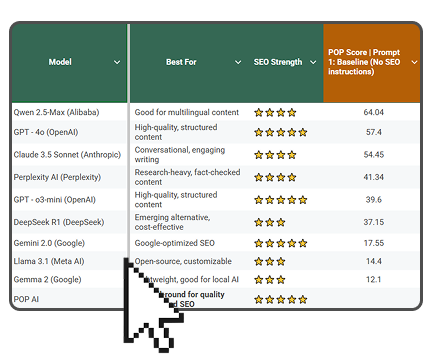Advanced on page SEO made simple.
Powered by POP Rank Engine™
Includes AI Writer
7-day refund guarantee
In the ever-evolving digital landscape, businesses constantly seek ways to enhance their online presence and improve their e-commerce performance. One effective method is through the implementation of product schema. This article explores the concept of product schema, its benefits, and practical tips on how to maximize its potential for your business.

Which is the best LLM for SEO content?
Get the full Gsheet of the results and scores from our study delivered straight to your inbox.
Understanding Product Schema
Product schema is a type of structured data that helps search engines understand the information on your web pages. It uses a specific vocabulary, defined by Schema.org, to mark up product details, including price, availability, reviews, and other attributes. When search engines recognize this structured data, they can present your product information more prominently in search results, often in rich snippets or knowledge graphs.
Benefits of Using Product Schema
Enhanced Search Visibility
One of the most significant benefits of product schema is improved search visibility. By providing search engines with detailed product information, your listings are more likely to appear in rich snippets. These enhanced search results can include star ratings, prices, and stock information, making your listings more attractive and clickable.
Improved Click-Through Rates (CTR)
Rich snippets not only make your listings stand out but also increase the likelihood of users clicking on your links. Studies have shown that rich snippets can significantly boost CTR, leading to more organic traffic and potential sales. This improved visibility and attractiveness can drive more targeted traffic to your e-commerce site.
Better User Experience
Product schema helps provide users with the information they need right in the search results. By seeing product ratings, prices, and availability upfront, users can make more informed decisions without needing to click through multiple pages. This streamlined experience can enhance user satisfaction and increase the chances of conversion.
Competitive Advantage
Incorporating Product schema gives you an edge over competitors who may not be using structured data. It allows your products to be showcased more prominently and attractively in search results, which can be a deciding factor for users comparing multiple options.
Which is the best LLM for SEO content?
Get the full Gsheet of the results and scores from our study delivered straight to your inbox.

Implementing Product Schema
Step-by-Step Guide
- Identify Key Product Attributes: Start by identifying the key attributes of your products that you want to highlight, such as name, description, price, availability, and reviews.
- Use Schema Markup Generator: Tools like Google's Structured Data Markup Helper or Schema.org's markup generator can assist in creating the necessary code. These tools guide you through adding structured data to your product pages.
- Add Schema Markup to Your Site: Once you've generated the schema markup, add it to the HTML of your product pages. This can be done manually or with the help of plugins if you are using a CMS like WordPress.
- Test Your Markup: Use Google's Rich Results Test or Schema Markup Validator to ensure your structured data is correctly implemented and eligible for rich results.
- Monitor and Optimize: After implementing product schema, monitor your search performance and CTRs. Use tools like Google Search Console to track the impact and make necessary adjustments.
Best Practices
Here are some of the best practices to keep in mind -
- Keep Information Accurate and Updated: Ensure that the information in your schema markup is accurate and regularly updated. Incorrect or outdated information can lead to poor user experiences and reduced trust.
- Include All Relevant Attributes: Make use of all relevant product attributes in your schema markup. The more comprehensive your data, the better search engines can understand and present your products.
- Leverage Reviews and Ratings: Including product reviews and ratings in your schema can significantly enhance your rich snippets, making them more appealing to users.
- Use JSON-LD Format: JSON-LD is the recommended format for adding structured data as it is easy to implement and maintain. It keeps the structured data separate from the HTML, reducing the risk of errors.
Case Studies
Case Study 1: E-Commerce Store Boosts Traffic by 30%
An online fashion retailer implemented product schema on their product pages, focusing on attributes like price, availability, and customer reviews. Within three months, they saw a 30% increase in organic traffic and a 20% increase in sales. The rich snippets made their products more visible and attractive in search results, leading to higher CTR and conversions.
Case Study 2: Small Business Gains Competitive Edge
A small electronics retailer used product schema to highlight key product features and customer ratings. As a result, their products started appearing in rich snippets, which was a significant advantage over competitors not using structured data. This visibility led to a 25% increase in click-through rates and a noticeable boost in overall sales.
Conclusion
Maximizing your potential with product schema is a strategic move for any e-commerce business. By enhancing search visibility, improving CTR, and providing a better user experience, product schema can significantly impact your online performance. Implementing it correctly and adhering to best practices will ensure that you reap the full benefits, giving you a competitive edge in the digital marketplace.







